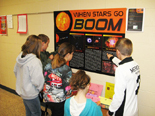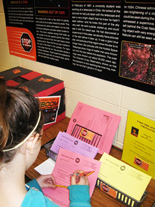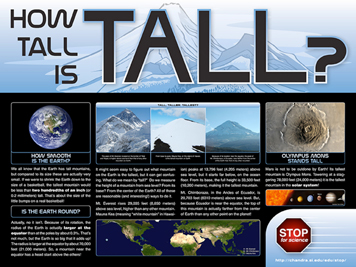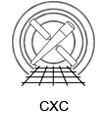
The goal of the "STOP for Science" (STOP) project: to promote access to science concepts and spark discussion of these topics among students, teachers, parents, and others. It does this by putting engaging science content in accessible locations tied to the school environment where social experiences are likely to occur, such as hallways, auditoriums, after-school programs, etc. Unlike traditional classroom activities, the STOP project aims to attract individuals who are curious about the content and participate with it voluntarily during their own free time.
STOP consists of a series of five posters and accompanying questions designed to pique student interest in science concepts and their application to the world in which we live. Accompanying each poster is a series of question sheets of increasing difficulty levels that students answer and submit at a designated location (collection box, office, etc.). Random prize drawings can be used to recognize/celebrate student participation. The purpose is to expose students to and create school-wide interest about science so students want to "STOP for Science" as displays are changed throughout the year. Although the focus is building-wide, content can be linked to classrooms through use of accompanying teacher/facilitator resource guides.
The STOP materials are part of a science enrichment program intended for Grades K-6. As described above, the program is designed for implementation outside of the formal classroom curriculum, but is carefully designed with materials to promote integration of topics into the formal classroom as desired, and with links to appropriate national standards for Science, Math, and English Language content.
In pilot testing, a series of five different science topics were introduced over the course of a year. All of the topics were introduced in the initial pilot study at Fiske Elementary School in Lexington, MA. Additionally, two of the posters were used with students in pilot tests, and the other three reviewed for content with elementary schools in Mukwonago, WI. Because the STOP program is intended to be school-wide, additional topics are being developed for use in subsequent years.
Each STOP poster stands alone and the concepts covered are not directly tied to those in the others. Therefore, the STOP posters may be displayed in any sequence or combination. STOP exposes students to a variety of familiar, yet challenging, science concepts utilizing simple explanations and illustrations as applied to real-life events. The materials in the STOP project are designed to serve as a precursor to in-depth studies included in upper grade level curriculum. As in any informal science learning setting, the desire to educate and inspire needs to be balanced with both the background and the interest level of the participant (Smith & Smith 2006; Smith, 2008). The STOP materials are designed to engage students in topics that are potentially relevant and applicable to their interests or experiences.
View the published papers on STOP and related programs.
Young students are natural scientists. They poke and prod, and compare and contrast the things around them. What is the fastest animal? Where is the tallest mountain? How does a rainbow work? And why do baseball players choke up on their bats? Teachers work hard to harness this energy and enthusiasm in the classroom, but particularly at an early age, science enrichment—that is, exposure outside the formal classroom—is crucial as well.
There is no shortage of studies that demonstrate the importance of science enrichment outside of the formal classroom environment. The National Research Council Committee on Learning Science in Informal Environments concludes that such enrichment forms a crucial element of all science learning (Bell et al. 2009). A study at Oregon State University (Falk and Dierking 2010) notes that less than 5% of a typical person's exposure to science topics originates inside the classroom, and argues that informal science enrichment thus forms the most important element to developing a scientifically literate and engaged public. While this study arguably understates the very crucial role that classroom instruction plays in teaching students how to learn science, it is quite clear that we need to creatively harness the time outside of the classroom to crystallize and broaden the lessons learned there.
The STOP materials went through the NASA Earth & Space Science educational product review where they received a strong recommendation by the science and education reviewers. Implementation plans for the STOP program were presented in a series of workshops at five National Science Teachers Association (NSTA) meetings as well as at meetings of the Astronomical Society of the Pacific (ASP) and Wisconsin Education Innovations. Materials for this phase of the program have been requested by over 250 schools distributed across 41 states (plus Washington, D.C and APO's; and including most of the lowest performing school districts[1]), and also in multiple countries through the International Astronomical Union Universe Awareness program.
[1] As of August 2012, STOP had reached Maine, Illinois, California, New Hampshire, Colorado, Minnesota, Washington, Kansas, Montana, Missouri, Utah, Oregon, Arizona, Mississippi, Alaska, Idaho, Nevada, District of Columbia (List sourced from Education Week, January 12, 2012. Quality Counts 2012, ERP Research Center)











